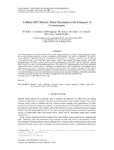Mostrar o rexistro simple do ítem
A multi-GPU shallow-water simulation with transport of contaminants
| dc.contributor.author | Viñas Buceta, Moisés | |
| dc.contributor.author | Lobeiras Blanco, Jacobo | |
| dc.contributor.author | Fraguela, Basilio B. | |
| dc.contributor.author | Arenaz Silva, Manuel | |
| dc.contributor.author | Amor, Margarita | |
| dc.contributor.author | García Rodríguez, José Antonio | |
| dc.contributor.author | Castro, M.J. | |
| dc.contributor.author | Doallo, Ramón | |
| dc.date.accessioned | 2021-11-19T20:02:15Z | |
| dc.date.available | 2021-11-19T20:02:15Z | |
| dc.date.issued | 2012 | |
| dc.identifier.citation | Viñas, M., Lobeiras, J., Fraguela, B., Arenaz, M., Amor, M., García, J., Castro, M. and Doallo, R. (2013), A multi-GPU shallow-water simulation with transport of contaminants. Concurrency Computat.: Pract. Exper., 25:. https://doi.org/10.1002/cpe.2917 | es_ES |
| dc.identifier.uri | http://hdl.handle.net/2183/28938 | |
| dc.description.abstract | [Abstract] This work presents cost-effective multi-graphics processing unit (GPU) parallel implementations of a finite-volume numerical scheme for solving pollutant transport problems in bidimensional domains. The fluid is modeled by 2D shallow-water equations, whereas the transport of pollutant is modeled by a transport equation. The 2D domain is discretized using a first-order Roe finite-volume scheme. Specifically, this paper presents multi-GPU implementations of both a solution that exploits recomputation on the GPU and an optimized solution that is based on a ghost cell decoupling approach. Our multi-GPU implementations have been optimized using nonblocking communications, overlapping communications and computations and the application of ghost cell expansion to minimize communications. The fastest one reached a speedup of 78 × using four GPUs on an InfiniBand network with respect to a parallel execution on a multicore CPU with six cores and two-way hyperthreading per core. Such performance, measured using a realistic problem, enabled the calculation of solutions not only in real time but also in orders of magnitude faster than the simulated time.Copyright © 2012 John Wiley & Sons, Ltd. | es_ES |
| dc.language.iso | eng | es_ES |
| dc.publisher | Wiley | es_ES |
| dc.relation.uri | https://doi.org/10.1002/cpe.2917 | es_ES |
| dc.subject | Shallow water | es_ES |
| dc.subject | Pollutant transport | es_ES |
| dc.subject | Finite volume methods | es_ES |
| dc.subject | CUDA | es_ES |
| dc.subject | Multi-GPU | es_ES |
| dc.subject | Recomputation | es_ES |
| dc.subject | Ghost cell decoupling | es_ES |
| dc.title | A multi-GPU shallow-water simulation with transport of contaminants | es_ES |
| dc.type | journal article | es_ES |
| dc.rights.accessRights | open access | es_ES |
| UDC.journalTitle | Concurrency and Computation: Practice and Experience | es_ES |
| UDC.volume | 25 | es_ES |
| UDC.startPage | 1153 | es_ES |
| UDC.endPage | 1169 | es_ES |
| dc.identifier.doi | 10.1002/cpe.2917 | |
| UDC.coleccion | Investigación | es_ES |
| UDC.departamento | Enxeñaría de Computadores | es_ES |
| UDC.grupoInv | Grupo de Arquitectura de Computadores (GAC) | es_ES |
Ficheiros no ítem
Este ítem aparece na(s) seguinte(s) colección(s)
-
Investigación (FIC) [1656]






